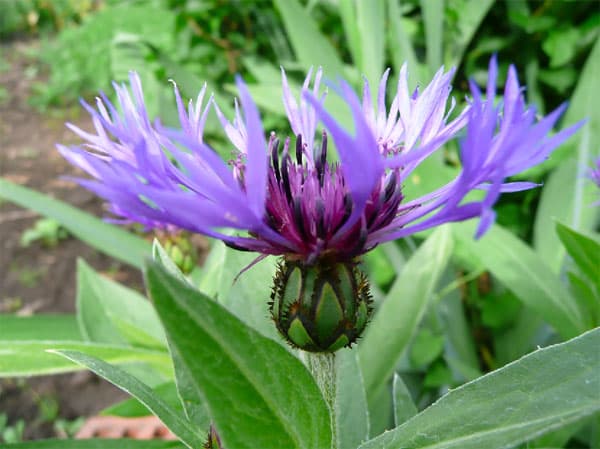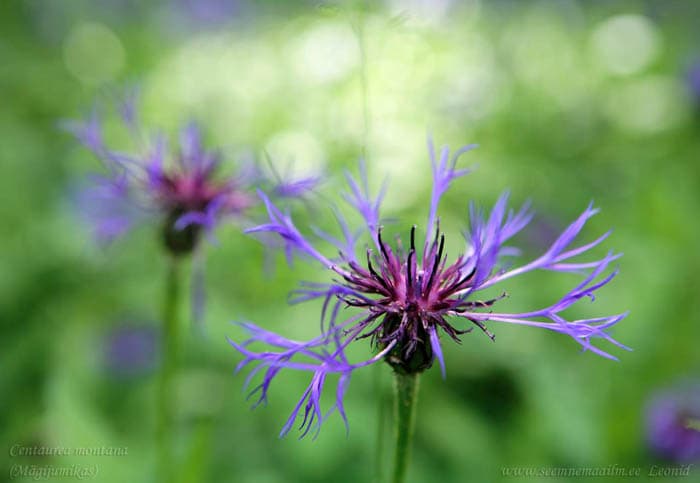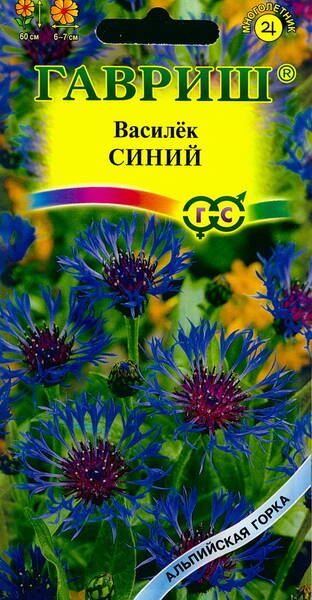Its homeland is the mountains of Western Europe, where it is found in large quantities in the alpine meadows of the Pyrenees, the Alps and the Balkans.
Mountain cornflower has a long, obliquely growing rhizome, deepened by 8-10 cm. The rhizome branches strongly, growing by 5-6 cm per year. At the end of summer, the buds of the next year's renewal are laid on it.
The basal leaves are whole, lanceolate, whitish-pubescent, on short petioles, collected in a rosette, overwintering. In June, stems with sessile alternate, also whole leaves covered with cobwebby pubescence grow.
The stems are erect (up to 60 cm high), usually unbranched. The bush is beautifully shaped. Despite the presence of long rhizomes, mountain cornflower looks like a bush plant.
It is consistently decorative throughout the season but is especially beautiful during the flowering period. Flowering begins in June and lasts for 2-2.5 months. Seeds ripen in August. The inflorescence is a basket of blue, or more precisely, deep blue-violet colour, 6 cm in diameter.
For its stability and beauty, this plant is widely grown in culture (since the middle of the 16th century). Mountain cornflower prefers sunny areas with fertile alkaline, well-drained soils, with normal moisture. Despite its southern origin, it tolerates spring frosts and winter frosts well. It is practically not damaged by diseases and pests.
It reproduces both by seeds (sowing before winter) and by dividing the bush (in spring or late summer). A true perennial - it grows for 7-10 years without division and transplantation.

Physical Characteristics: Perennial growing to 0.45m by 1m.
It is hardy to zone 3 and is not frost tender. It is in flower from May to August, and the seeds ripen from July to September. The flowers are hermaphrodite (have both male and female organs) and are pollinated by Bees, flies and Lepidoptera (Moths & Butterflies). The plant is self-fertile. It is noted for attracting wildlife. We rate it 1 out of 5 for usefulness. The plant prefers light (sandy), medium (loamy) and heavy (clay) soils, requires well-drained soil and can grow in nutritionally poor soil. The plant prefers acid, neutral and basic (alkaline) soils and can grow in very alkaline soil. It cannot grow in the shade. It requires dry or moist soil and can tolerate drought.
Habitats and Possible Locations: Woodland, Sunny Edge, Ground Cover.
Cultivation details.
Succeeds in ordinary garden soil. Prefers a moist well-drained fertile soil and a sunny position. Tolerates dry, low fertility and alkaline soils. Plants are hardy to at least -20°C. A very ornamental plant, there are some named varieties. The plants have creeping rhizomes and form spreading patches. A good bee plant. Members of this genus are rarely if ever troubled by browsing deer.
Propagation Seed - sow March in a greenhouse. When they are large enough to handle, prick the seedlings out into individual pots and plant them out into their permanent positions in the summer. The seed is best sown as soon as it is ripe in August in a greenhouse, overwintered under cover, and planted out in spring. Division in autumn. Very easy, larger clumps can be replanted direct into their permanent positions, though it is best to pot up smaller clumps and grow them on in a cold frame until they are rooting well. Plant them out in the summer or following spring. This should be done at least once every three years in order to maintain the plants vigour. Basal cuttings in spring. Harvest the shoots when they are about 5 - 10 cm long with plenty of underground stem. Pot them up into individual pots and keep them in light shade in a cold frame or greenhouse until they are rooting well. Plant them out in the summer.
.jpg)

Mountain cornflower "Blue", mountain knapweed, mountain bluet. Bot. syn.: Cyanus montana (L.) Hill.












